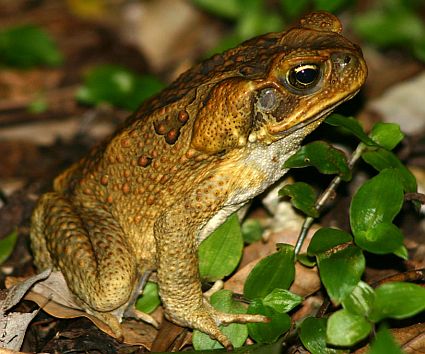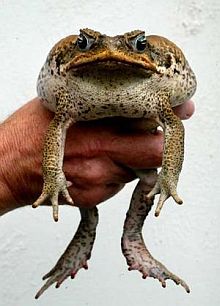
Cane toads have proven themselves to be one of Australia’s worst environmental disasters. The Australian government is at its wits end on how to stop their increasing numbers. However, a new study hopes to ally their fears, it suggests that Cane toads might finish themselves off because of a cannibalistic tendency.
While studying captive toads, the Sydney University scientists discovered that adults often wiggle their toes when around young toads, prompting the latter to hop towards them, apparently mistaking the toes for a juicy insect – their main diet. The adults then gobble up the youngsters.
Human introduction of this invasive species
Cane Toads were introduced to Australia to eat French’s Cane Beetle and the Greyback Cane Beetle. The ‘whitegrub’ larvae of these beetles eat the roots of sugar cane and kill or stunt the plants. The Australian Bureau of Sugar Experimental Stations imported about 100 toads from Hawaii to the Meringa Experimental Station near Cairns. The toads bred quickly and more than 3000 were released in the sugar cane plantations of north Queensland in July 1935.
Cane Toads are considered a pest in Australia because:

All stages of a toad’s life are poisonous so they have no natural predators to keep their numbers in check. So they poison pets and injure humans with their toxins
They also poison many native animals whose diet includes frogs, tadpoles and frogs’ eggs
By eating a large numbers of honey bees, creating a management problem for bee-keepers
compete for food with vertebrate insectivores such as small skinks
They have ravaged populations of indigenous fauna, including kookaburras, snakes, goannas (a type of sand monitor) and quolls (native marsupial cats). Their skin remains poisonous after death, and even dingoes and freshwater crocodiles have died after eating them.
They breed like flies, as the saying goes. Each pair of cane toads can lay 33,000 eggs per spawning (some published references estimate they produce as much as 60,000 eggs!).
At that time, some naturalists and scientists warned of the dangers of liberating Cane Toads in Australia. Since they were not adhered to the problem looms large.
Professor Rick Shine said the toad-eat-toad behaviour could be exploited to reduce the number of the creatures, that have colonised Australia and become the country’s worst pest.
He suggested that physical adaptation of ponds, to encourage toads to breed in the same place, could increase cannibalism. If more young were eaten, there would be a drop in the number of toads mature enough to breed.
His team also discovered that male toads often drown females when copulating with them in water. If females were targeted through culling so they were outnumbered by males it would lead to more being drowned.
At a point when extraordinary amount of money has and is still being spent by the Australian government on genetically manipulating a disease to kill toads this seems to be a welcome break.
Image credit: [1], [2]
Source: The Independent

